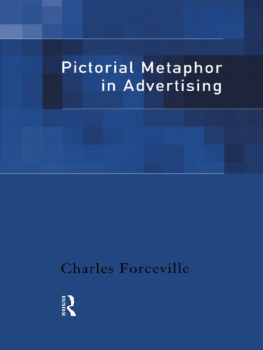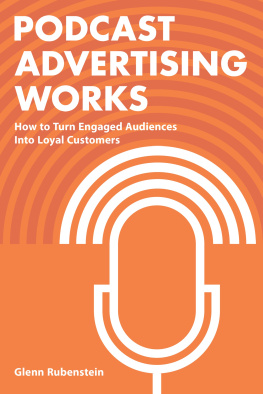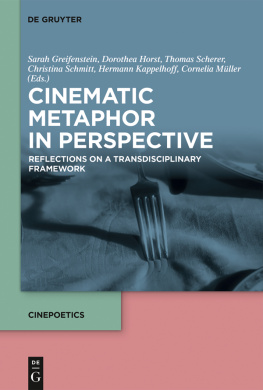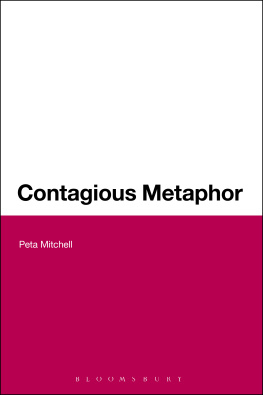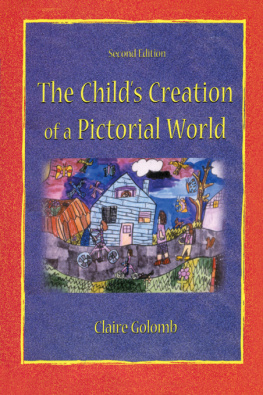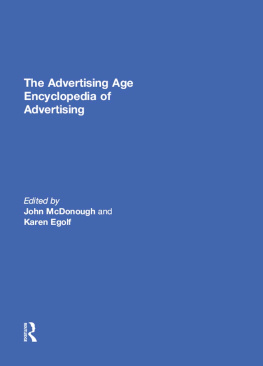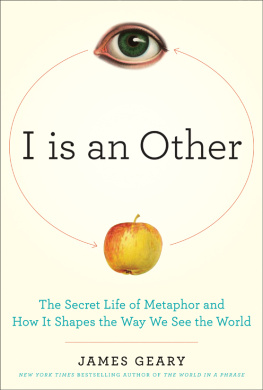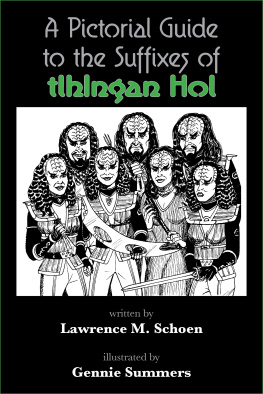Forceville - Pictorial Metaphor in Advertising
Here you can read online Forceville - Pictorial Metaphor in Advertising full text of the book (entire story) in english for free. Download pdf and epub, get meaning, cover and reviews about this ebook. year: 2011, publisher: TaylorFrancis, genre: Romance novel. Description of the work, (preface) as well as reviews are available. Best literature library LitArk.com created for fans of good reading and offers a wide selection of genres:
Romance novel
Science fiction
Adventure
Detective
Science
History
Home and family
Prose
Art
Politics
Computer
Non-fiction
Religion
Business
Children
Humor
Choose a favorite category and find really read worthwhile books. Enjoy immersion in the world of imagination, feel the emotions of the characters or learn something new for yourself, make an fascinating discovery.
- Book:Pictorial Metaphor in Advertising
- Author:Forceville / Ch
- Publisher:TaylorFrancis
- Genre:
- Year:2011
- Rating:3 / 5
- Favourites:Add to favourites
- Your mark:
- 60
- 1
- 2
- 3
- 4
- 5
Pictorial Metaphor in Advertising: summary, description and annotation
We offer to read an annotation, description, summary or preface (depends on what the author of the book "Pictorial Metaphor in Advertising" wrote himself). If you haven't found the necessary information about the book — write in the comments, we will try to find it.
Pictorial Metaphor in Advertising — read online for free the complete book (whole text) full work
Below is the text of the book, divided by pages. System saving the place of the last page read, allows you to conveniently read the book "Pictorial Metaphor in Advertising" online for free, without having to search again every time where you left off. Put a bookmark, and you can go to the page where you finished reading at any time.
Font size:
Interval:
Bookmark:

Over the past few decades, research on metaphor has focused almost exclusively on its verbal and cognitive dimensions. In Pictorial Metaphor in Advertising, Charles Forceville argues that metaphor can also occur in pictures. By using insights taken from a range of linguistic, artistic, and cognitive perspectives, for example, interaction and relevance theory, Forceville shows not only how metaphor can occur in pictures, but also provides a framework within which these pictorial metaphors can be analysed.
The theoretical insights are applied to thirty advertisements and billboards of British, French, German, and Dutch origin. Apart from substantiating the claim that it makes sense to talk about pictorial metaphors, the detailed analyses of the advertisements suggest how metaphor theory can be employed as a tool in media studies. The final chapter of this book looks at ways in which the insights gained can be used for further research.
This book will be of interest to advanced undergraduate and graduate students of Communication Studies, Language, and Linguistics.
Charles Forceville is Lecturer in the Department of English, also affiliated to the Department of Comparative and Empirical Literature at the Free University in Amsterdam.
First published 1996
by Routledge
11 New Fetter Lane, London EC4P 4EE
This edition published in the Taylor & Francis e-Library, 2002.
Simultaneously published in the USA and Canada
by Routledge
29 West 35th Street, New York, NY 10001
First published in paperback 1998
1996 Charles Forceville
All rights reserved. No part of this book may be reprinted or reproduced or utilized in any form or by any electronic, mechanical, or other means, now known or hereafter invented, including photocopying and recording, or in any information storage or retrieval system, without permission in writing from the publishers.
British Library Cataloguing in Publication Data
A catalogue record for this book is available from the British Library
Library of Congress Cataloguing in Publication Data
A catalogue record for this book has been requested
ISBN 0-415-12868-4 (hbk)
ISBN 0-415-18676-5 (pbk)
ISBN 0-203-06425-9 Master e-book ISBN
ISBN 0-203-20910-9 (Glassbook Format)
The selection of mappable features in a verbal metaphor
Rhetorical figures in the advertising image. Source: Durand 1987:296
Jakobsons (1960) communication model
The influence of pictorial context upon perception. Source: Bosch 1985:146
The influence of pictorial context upon similarity judgments. Source: Tversky 1977:341
Source: Advertising agency: Publi-Est/Gerstenhaber + Cie.
Source: doctored version of Figure 6.1
The selection of mappable features in a pictorial metaphor
Source: Advertising agency: Beverly-Markagri, Groupe Publicis
Source: Advertising agency: FHV/BBDO
Source: Advertising agency: DDB, New York
Source: Advertising agency: HCM
Source: Advertising agency: HCM
Source: Advertising agency: PPGH/JWT
Source: Advertising agency: Abbott Vickers/SMS Ltd.
Source: Advertising agency: Baums, Mang und Zimmermann, Dsseldorf
Primary subjects, secondary subjects and projected features in pictorial metaphors
Source: Advertising agency: McCann-Erickson
Source: Advertising agency: KVH/GGK
Source: Advertising agency: HCM
Source: Advertising agency: PPGH/JWT
Source: doctored version of Figure 6.16
Source: Advertising agency: Foot, Cone & Belding
Source: Advertising agency: Young & Rubicam
Source: Advertising agency: Campaign Company
Source: Advertising agency: Noordervliet & Winninghoff/Leo Burnett
Source: Advertising agency: Young & Rubicam
Source: Advertising agency: PPGH/Moussault
Source: Advertising agency: PPGH/JWT
Source: Advertising agency: J.Walter Thompson
Source: Realization: Hans Haselaar, Wim Ubachs, Roel Salomons
Source: Advertising agency: FHV/BBDO
Source: Advertising agency: HSR & S
Source: Advertising agency: DDB Needham
Source: Advertising agency: GGK Amsterdam
Source: Advertising agency: GGK Amsterdam
Source: Advertising agency: GGK Amsterdam
Every attempt has been made to obtain permission to reproduce copyright material, and publisher and author would like to thank the copyright holders who granted permission to reprint their advertisements and billboards in this book. If any proper acknowledgement has not been made, we would invite copyright holders to inform Routledge of the oversight.
A metaphor is the result of the interaction between two different domains; completing a book on metaphor is the result of the interaction with numerous people. First of all I want to thank Elrud Ibsch and Lachlan Mackenzie (both Vrije Universiteit Amsterdam), who monitored and commented upon the progress of this book from its earliest beginnings. I have benefited much both from their expertise and their enthusiasm. Apart from closely watching over the books overall structure, Elrud managed to convince me that the book would gain by the incorporation of an empirical component. To Lachlan I want to express my gratitude for giving me the first taste of metaphor. His inspiring seminar on the subject in the early 1980s was for me the beginning of what may well prove a life-long addiction. Furthermore, the text owes much to his thoughtful comments and meticulous editing.
Among my colleagues in the Department of English and the Department of Comparative and Empirical Literature at the Vrije Universiteit Amsterdam I would like to thank specifically Johan Hoorn, Dick Schram, and Gerard Steen. The formal and informal discussions in this group helped foster the kind of research climate without which no scholar can thrive.
While the academic community tends to agree readily that interdisciplinary research deserves priority in funding decisions, the extent to which this conviction is practised is often disappointing. I am therefore much indebted to NWO (Netherlands Organization for Scientific Research) for subsidizing the somewhat unconventional project of which this book is the fruit, and for the grants that allowed me to present my research abroad.
Various chapters or parts of chapters in this book have been, or will be, published in scholarly journals and collections of essays. In writing and rewriting for the journals I learnt much from critical reports on submitted articles.
Among the many academics whose suggestions and encouragement came at moments when this was particularly welcome I would like to single out Guy Cook, Leo Hoek, John Dixon Hunt, Mark Johnson, John Kennedy, and Jaap H.Spoor.
Many people have commented over the years on ads and billboards in seminars, lectures, and during conferences. The fact that often I do not even know their names does not detract from the fact that many of their observations have found their way into my analyses.
For years Marieke Nieuwland of the Nederlandse Vereniging van Erkende Reclame Adviesbureaus (VEA) and Marie-Lou Florisson of the Art Directors Club Nederland (ADCN) generously allowed me to consult their archives, and helped me find the information I needed. I much enjoyed the brief glimpses into the world of advertising, so vastly different from the academic one, which my visits to the VEA and the ADCN afforded me.
Font size:
Interval:
Bookmark:
Similar books «Pictorial Metaphor in Advertising»
Look at similar books to Pictorial Metaphor in Advertising. We have selected literature similar in name and meaning in the hope of providing readers with more options to find new, interesting, not yet read works.
Discussion, reviews of the book Pictorial Metaphor in Advertising and just readers' own opinions. Leave your comments, write what you think about the work, its meaning or the main characters. Specify what exactly you liked and what you didn't like, and why you think so.

